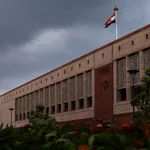Shopian, Jun 16: In a joint effort to preserve the endangered Pir Panjal Markhor in the picturesque Hirpora wildlife sanctuary in south Kashmir’s Shopian district, the Wildlife Trust of India (WTI) partnered with the Department of Wildlife Protection and a support from the Astral Foundation to conduct a comprehensive training and capacity building program.
The initiative aimed to equip frontline staff with the skills and knowledge necessary for the systematic monitoring of critical markhor habitats in the sanctuary.
Hirpora wildlife sanctuary, with its snow-clad peaks and high altitude lakes, serves as a vital refuge for the world’s largest mountain goat, the Pir Panjal Markhor (Capra falconeri cashmiriensis).
However, this near-threatened species has faced severe challenges due to uncontrolled large-scale grazing and the persistent threat of poaching. Consequently, the markhor’s population and habitat have suffered significant setbacks in the state of Jammu and Kashmir.
To combat these threats and safeguard the markhor population, Wildlife Trust of India, in collaboration with the Department of Wildlife Protection, organized a one-day training session for frontline staff.
An official of WTI said that the primary objective was to enhance their abilities and morale in order to regulate livestock grazing within the sanctuary effectively.
Under the initiative, monitoring and anti-grazing camps have been established at strategic locations throughout the sanctuary. These camps ensure that no livestock herders pass through the critical markhor habitats. To support the monitoring activities in the protected area, the teams were equipped with camping essentials, including solar lights, utensils, and gas stoves.
During the training, the frontline staff were provided with valuable insights into identifying markhor scats and pellets, as well as the practical use of GPS devices in the field. Intesar Suhail, Wildlife Warden of Shopian, conducted the initial session, delving into the intricacies of livestock monitoring. Emphasizing the importance of engaging with migratory herders, Suhail highlighted how the overuse of pastures by these herders had led to the displacement of markhor from key habitats.
Dr. Tanushree Srivastava, Manager and Project Head of the Western Himalaya Mountain Ungulate Projects at WTI, then conducted an interactive training session. Dr. Srivastava focused on the various challenges faced in markhor conservation and provided guidance on the proper use of GPS devices for effective monitoring.
Furthermore, Sameer Khazir, Assistant Manager at Wildlife Trust of India, oriented the staff on evidence collection and documentation, emphasizing the significance of accurate data in conservation efforts.
The workshop was attended by key individuals committed to markhor conservation, including Intesar Suhail (Wildlife Warden of Shopian), Mohammad Lateef Wani (Range Officer of Hirpora Wildlife Sanctuary), Nadeem Ahmad Dar (Forester of Hirpora Wildlife Sanctuary), Dr. Tanushree Srivastava (Manager and Project Head of Western Himalaya Mountain Ungulate Projects at WTI), and Sameer Khazir (Assistant Manager at Wildlife Trust of India).
With the successful completion of this training and capacity building initiative, the Wildlife Trust of India and its partners are hopeful that the frontline staff will be better equipped to regulate livestock grazing, thereby safeguarding the critical markhor habitats in Hirpora wildlife sanctuary. This collaborative effort serves as a beacon of hope for the endangered Pir Panjal Markhor, ensuring its continued existence in the stunning landscapes of Jammu and Kashmir.





